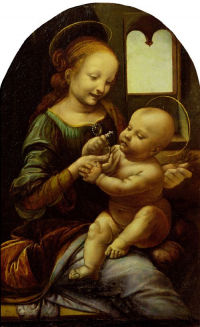
- Enlarge
- Zoom & explore
- © Hermitage, St. Petersburg, Russia/Bridgeman
Madonna and Child (The Benois Madonna) c1479-80
In this small panel, which is was probably intended for private devotion, Leonardo concentrated on the special nature of the relationship between the Christchild and his mother, using every means at his disposal to achieve an incredible sense of intimacy and emotional expression.
Mother and child are situated in a dark, domestic interior that conveys the intimacy and closeness of their bond, its dramatic chiaroscuro lighting further unifying and conveying the unprecedented sense of plasticity of their forms. Numerous preparatory compositional sketches related to this painting suggest that Leonardo evolved the composition by means of the “brainstorming” technique of drawing, whereby the artist drew repeatedly and at speed on one area of the paper, directly from his imagination, until a suitable compositional solution evolved.
A heightened sense of naturalism is evident throughout all elements of the painting, including the Virgin’s expression of delight, the flowers and grasses that she holds, and the intensity of the child’s concentration - all of which confirm Leonardo’s direct study of nature through drawing. It also seems likely that the artist was influenced by Netherlandish paintings and the oil painting techniques of artists such as Van Eyck and Rogier Van der Weyden.
- Medium Oil on canvas (transferred from panel in 1824)
- Size 48 x 31 cm
- Location The State Hermitage Museum
